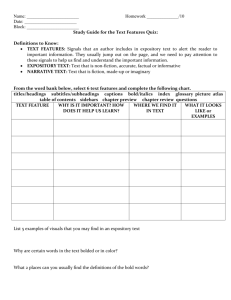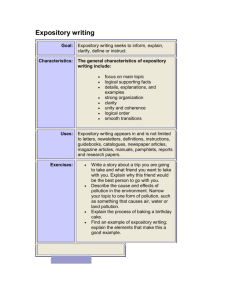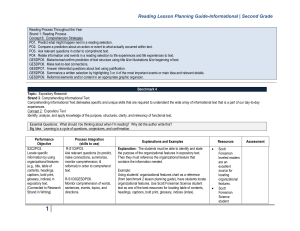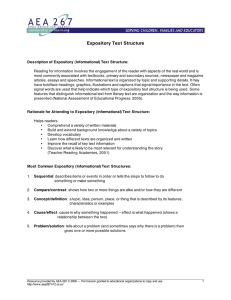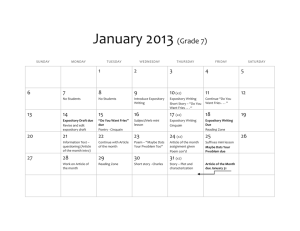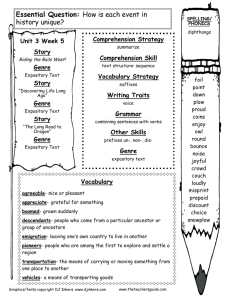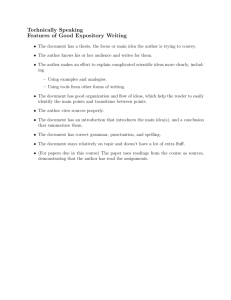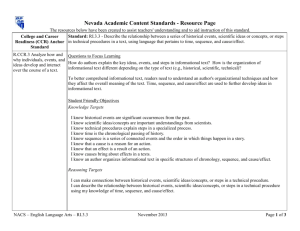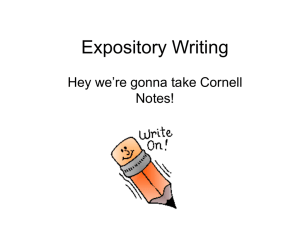2 Second Grade Lesson Planning Guide
advertisement
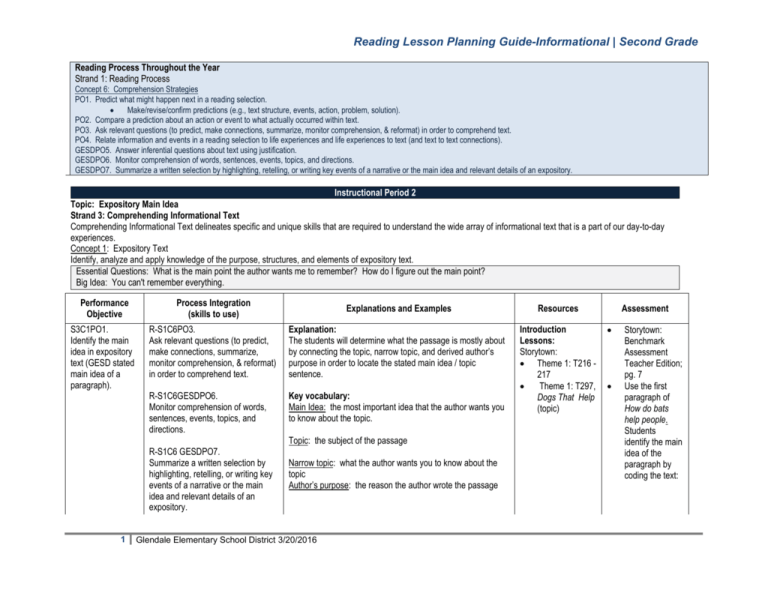
Reading Lesson Planning Guide-Informational | Second Grade Reading Process Throughout the Year Strand 1: Reading Process Concept 6: Comprehension Strategies PO1. Predict what might happen next in a reading selection. Make/revise/confirm predictions (e.g., text structure, events, action, problem, solution). PO2. Compare a prediction about an action or event to what actually occurred within text. PO3. Ask relevant questions (to predict, make connections, summarize, monitor comprehension, & reformat) in order to comprehend text. PO4. Relate information and events in a reading selection to life experiences and life experiences to text (and text to text connections). GESDPO5. Answer inferential questions about text using justification. GESDPO6. Monitor comprehension of words, sentences, events, topics, and directions. GESDPO7. Summarize a written selection by highlighting, retelling, or writing key events of a narrative or the main idea and relevant details of an expository. Instructional Period 2 Topic: Expository Main Idea Strand 3: Comprehending Informational Text Comprehending Informational Text delineates specific and unique skills that are required to understand the wide array of informational text that is a part of our day-to-day experiences. Concept 1: Expository Text Identify, analyze and apply knowledge of the purpose, structures, and elements of expository text. Essential Questions: What is the main point the author wants me to remember? How do I figure out the main point? Big Idea: You can't remember everything. Performance Objective Process Integration (skills to use) Explanations and Examples Resources S3C1PO1. Identify the main idea in expository text (GESD stated main idea of a paragraph). R-S1C6PO3. Ask relevant questions (to predict, make connections, summarize, monitor comprehension, & reformat) in order to comprehend text. Explanation: The students will determine what the passage is mostly about by connecting the topic, narrow topic, and derived author’s purpose in order to locate the stated main idea / topic sentence. R-S1C6GESDPO6. Monitor comprehension of words, sentences, events, topics, and directions. Key vocabulary: Main Idea: the most important idea that the author wants you to know about the topic. Introduction Lessons: Storytown: Theme 1: T216 217 Theme 1: T297, Dogs That Help (topic) R-S1C6 GESDPO7. Summarize a written selection by highlighting, retelling, or writing key events of a narrative or the main idea and relevant details of an expository. 1 Topic: the subject of the passage Narrow topic: what the author wants you to know about the topic Author’s purpose: the reason the author wrote the passage Glendale Elementary School District 3/20/2016 Assessment Storytown: Benchmark Assessment Teacher Edition; pg. 7 Use the first paragraph of How do bats help people. Students identify the main idea of the paragraph by coding the text: Reading Lesson Planning Guide-Informational | Second Grade W-S3C6PO1. Locate and use informational sources to write a simple report that includes: a. title b. a main idea c. supporting details Content Knowledge: The stated main idea can be located in the beginning, middle, or end of a paragraph. To confirm the stated main idea make text to text connections with the relevant details. Ex. Coins are worth different values. (stated main idea) A penny is worth one cent. (relevant detail) Example: Mini Lesson: Anchor chart “Getting the Gist” Anchor chart highlights the process for identifying the stated main idea Construct in front of students Review Stated Main Idea with Cadence Stated Main Idea It’s important that you find, The point the author has in mind. The main idea is its name A “topic sentence” is the same. Find the topic reading through Locate repeated words, yes you do. Circle the subject as you go Then the topic you will know. What’s the author telling me? Soon the purpose you will see. The author’s most important view Will include the topic, too The topic sentence is top-shelf It makes good sense all by itself. It can’t be found in just one spot, Look around ‘til you get hot. 2 Glendale Elementary School District 3/20/2016 Topic: Circle Relevant Detail: Underline Additional Information: Cross out Stated Main Idea: Highlight Reading Lesson Planning Guide-Informational | Second Grade The topic sentence you can find, When you do, then underline. It will make sure that you know The point the author wants to show. MAIN IDEA! MAIN IDEA! MAIN IDEA! Meta-cognitive model: Rainforest paragraph Code Topic: Circle Relevant Detail: Underline Additional Information: Cross out Stated Main Idea: Highlight The rainforest is an important resource for our world. Rainforests help to regulate the world’s climate by absorbing carbon dioxide and producing oxygen. As trees are cut down, less carbon dioxide is absorbed, which contributes to global warming. Rainforests are home to millions of species of plants and animals, more than half of the world’s species. The boa constrictor, red-eyed tree frog, and orangutan are some of the animals that dwell in the rainforest. Many medicines are made from rain forest plants. The Mammosa fruit found in the rainforest are boiled in water and the steam inhaled to treat sinus infections. (www.rainforesteducation.com) Frogs Frogs change as they grow. This change is called a life cycle. A frog begins its life as a little egg. The egg is no bigger than the eraser on your pencil. The egg hatches into a tadpole. A tadpole is a baby frog with a tail. As it grows, back and front legs slowly appear and the tail disappears. The tadpole changed into a frog. 3 Glendale Elementary School District 3/20/2016 Frogs Start First Begins egg Tadpole Transforms Develop Changes frog Frogs change as they grow. Develop Mature Reading Lesson Planning Guide-Informational | Second Grade Summary: As frogs mature they change. Frogs begin as eggs and emerge into tadpoles. Then the tadpoles transform into frogs. S3C1PO2. Locate facts in response to questions about expository text. R-S1C6PO3. Ask relevant questions (to predict, make connections, summarize, monitor comprehension, & reformat) in order to comprehend text. Explanation: The students will use stated information from the expository text to answer given questions. R-S1C6 GESDPO7. Summarize a written selection by highlighting, retelling, or writing key events of a narrative or the main idea and relevant details of an expository. Example: Provide each student access to an expository passage or text. Read the passage or text together. After reading, have students identify the topic of the passage or text. Create a circle map with the topic identified. Have students generate information learned by the reading of the passage or text. Record the information on the circle map. Teacher will generate questions based on the information on the circle map. Students will locate the answers to the questions within the text. Content Knowledge: Facts are details that give specific information about a topic. fly at night Bats eat insects After each posed question have the children go back into the text and prove the answer. 4 Glendale Elementary School District 3/20/2016 What do bats eat at night? Introduction Lessons: Storytown: Leveled Readers: Peanuts Theme 1, T 296297 Read Aloud Anthology: Go Fetch, pg. 16 Storytown: Theme 5; T277 Make a diagram about an animal or ____ that you would like to write about. Create a graphic organizer shown on page 114 for expository text. Extra Support; pg. 24 Practice Book; pg. 24 Challenge Book; pg. 24 Reading Lesson Planning Guide-Informational | Second Grade S3C2PO3. Locate specific information by using organizational features (e.g., title, table of contents, headings, captions, bold print, glossary, indices) in expository text. (Connected to Research Strand in Writing) When do bats fly? . What does nocturnal mean? How do bats use echolocation? R-S1C6PO3. Ask relevant questions (to predict, make connections, summarize, monitor comprehension, & reformat) in order to comprehend text. Explanation: The students must be able to identify and state the purpose of the organizational features in expository text. Then they must reference the organizational feature that contains the information needed. R-S1C6GESDPO6. Monitor comprehension of words, sentences, events, topics, and directions. Content Knowledge: Convention Labels A.V. Organizational features Photographs Captions Maps Table of Contents Index Glossary Purpose Help the reader identify a picture or photograph and /or its parts Help the reader understand exactly what something looks like Help the reader better understand a picture or photograph Help the reader to understand material in text through visual representation Help reader to understand text organization and locate information Help reader to find topics of interest Helps reader to locate unknown words and deepen understanding of vocabulary Example: (Building Prerequisite Skills) 5 Glendale Elementary School District 3/20/2016 Scott Foresman leveled readers are an excellent source for locating organizational features. Scott Foresman Science student textbook. Reading Lesson Planning Guide-Informational | Second Grade Have the students build an organizational features reference chart. The reference chart should include the following: List the caption Kid friendly definition Purpose Example List questions that can be answered using the organizational feature Example entry on the reference chart Table of Contents: An ordered list of the names of the sections and / or chapters of the book with page numbers. Purpose: Help the reader identify key topics in the book in the order they are presented Table of Contents What Are Frogs………………………..….1 Frog Habitats……………………….……3 Life Cycle…………………………………5 Questions: What page is Frog Habitats on? Where would you look for information on a frog’s life cycle? Is a frog a reptile? S3C2PO4. Identify a variety of sources (e.g., trade books, encyclopedias, magazine, electronic, resources, textbooks) that may be used to answer specific questions and /or 6 R-SC6PO4. Relate information and events in a reading selection to life experiences and life experiences to text (and text to text connections). W-S3C6PO1. Locate and use informational sources to write a simple report that includes: a. title Explanation: The students will connect a resource to information needed either to answer a specific question or inquiring about a specific topic. Content Knowledge: Because of the quantity of information available, students need to become strategic in their selection of sources that will help them find information and be able to use the information. There are many types of informational sources and a wide range of features that define the different sources. Therefore students need to become flexible in their selection of sources. Glendale Elementary School District 3/20/2016 Introduction Lessons: Scott Foresman Science textbook Magazines for example: Ranger Rick, Zoobooks, My Backyard, etc. Reading Lesson Planning Guide-Informational | Second Grade gather information. (Connected to Research Strand in Writing) b. c. a main idea supporting details A.V. Informational source S3C2PO5. Locate specific information from graphic features (e.g., charts, maps, diagrams, illustrations, tables, and timelines) of expository text. (Connected to Research Strand in Writing) R-SC6PO4. Relate information and events in a reading selection to life experiences and life experiences to text (and text to text connections). W-S3C6PO1. Locate and use informational sources to write a simple report that includes: a. title b. a main idea c. supporting details W-S3C2PO2. Participate in creating simple 7 They need to ask themselves: “What source of information will meet my need?” Encyclopedias Example: Teaching Locating Specific Information Have student place I wonder cards into an I wonder box. EX. I wonder how a rainbow is formed in the sky? Pick an I wonder question. Model what you do when you want to find out specific information to answer a question. Pose the following questions during your metacognitive model: o What do I already know about the topic? o What type of resource will help me locate information to answer my question? o How is the information organized in the resource? o How will I go about locating what I need? After locating the information needed: o What did I learn? o How can I synthesize my learning? o Do I have any other questions about _____? Tradebooks from the school library or classroom library. Explanation: Students will use graphic features in expository text to locate information. Introduction Lessons: Scott Foresman Science student textbook: Content Knowledge: Graphic features are pictorial representation of the written text. The purpose of the graphic feature is to communicate content information visually to deepen the understanding of the written text. Pictorial representations include illustrations, photos, diagrams, charts, and graphs to assist us with understanding the content of the material. Students need to be explicitly taught how to question, predict or make observations of the graphic feature to connect with the written content information represented in the pictorial representation. Helping students to take the time to evaluate these features’ Glendale Elementary School District 3/20/2016 Timeline: Lesson 5 p. 114115 ; p. 124-125 Tables,p. 93, p. 412, p. 386 Charts, p. 196197;p. 225, p. 161,p. 195, p.229, p.259, p.293, p.323, Reading Lesson Planning Guide-Informational | Second Grade summaries of informational text, graphs, tables, or maps A.V. Graphic features and their purpose will only enhance their understanding of the text. Graphs and charts often depict things that are easier to understand in symbolic format. These are often best used as a resource instead of trying to memorize every fact within them. When teaching how to use this type of visual, remember to note that many charts offer not only information, but also comparisons and processes between and among important concepts (Robb, Klemp, and Schwartz, 2002). Example: This lesson is an example of how to teach children to activate prior knowledge, generate questions, make predictions and observations relating to the graphic feature as a processing technique. Having students generate questions and observations (predictions) before reading the written text will allow them to connect personally. After the students generate questions and observations the written text is then read. The most important part of the lesson comes at the end where the students take their own questions and observations and see if they accurately predicted the content of the graphic feature. The oral connections from their predictions to the actual validation of written text will support their comprehension. 8 Glendale Elementary School District 3/20/2016 p.357, p.421 Storytown: Theme 3Lesson 15; p T416-417; (pictoral timeline) Reading Lesson Planning Guide-Informational | Second Grade Butterflies and moths undergo complete metamorphosis in which they go through four different life stages. Egg - A butterfly starts its life as an egg. Larva - The larva (caterpillar) hatches from an egg and eats leaves or flowers almost constantly. The caterpillar molts (loses its old skin) many times as it grows. Pupa - It turns into a pupa (chrysalis); this is a resting stage. Adult - A beautiful, flying adult emerges. There is no growth during this stage. This adult will continue the cycle and reproduce. Step 1: 1. Give each student two index cards. On one card put a Q and the other card put an O. 2. Allow student to just look at the visual representation of a lifecycle of a butterfly. Do not read the text. 3. Have the students begin to ask questions regarding the visual without any answers. DO NOT ASK THE QUESTIONS FOR STUDENTS TO ANSWER. If 9 Glendale Elementary School District 3/20/2016 Reading Lesson Planning Guide-Informational | Second Grade students are having difficulty asking questions, then model generating questions. Then scaffold developing personal questions. 4. Once many questions have been orally generated regarding the visual, have each student write a question on the Q card. Step 2: 1. Now have students begin making observations about the visual. Observations do not have to be correct. Again, do not make observations for students. Model and scaffold support to make an observation. 2. Once students have produced many oral observations have each student write their own observation on the O card. 3. Once cards are completed. Gather students on floor to sort cards into a Q pile and O pile. Orally read together the text below the visual representation of the life cycle. 4. Once the text has been read and understood, have students reread the questions they posed and the observations. 5. One idea for connecting the observations to the text is to sort by confirmed observation or revise. An idea for connecting the questions to the text is sorting them by answered or need more information. Connection: See if the students’ questions that were “answered” by observations and confirmed by the text supported the students with comprehending the overall concept. Students will then see the connection of questioning before reading, making observations regarding visual representation and the comprehension of the text. 10 Glendale Elementary School District 3/20/2016 Reading Lesson Planning Guide-Informational | Second Grade S3C1GESDPO9. Confirm stated main idea of a paragraph with narrow topic, author’s purpose and relevant details. R-S1C6PO3. Ask relevant questions (to predict, make connections, summarize, monitor comprehension, & reformat) in order to comprehend text. W-S3C2PO1. Write expository text (e.g., labels, lists, observations, journals). Explanation: The students will use the identified narrow topic, author’s purpose, and relevant details to justify what the paragraph is mostly about. Content Knowledge: To confirm the stated main idea connect the relevant details and authors purpose. All relevant details have the topic and authors purpose embedded within the sentence. Example: Using the text bats, code it for the following: Topic (circle) Relevant Details (underline) Additional Information (strike through) Stated Main Idea (highlight) Derive the author’s purpose To inform what about the topic To explain what about the topic Text: Bats Bats Bats use echolocation to locate food. Echolocation is a unique way to use sound. Bats send out sound waves that bounce off their prey. They eat 250 tons of insects a night. Then the sound waves come back to the bat as echoes. The bat can tell by the type of echo what type of insect it is and its location. Next lift the main idea and relevant detail sentences to show direct connection between the topic and authors purpose. Narrow Topic: Bats Author’s Purpose: to explain how bats use echolocation to locate food. Main Idea: Bats use echolocation to locate food Relevant Details: 11 Glendale Elementary School District 3/20/2016 Introduction Lessons: Supplemental Resources: Concept Poems http://portals.ges d40.org/district/c i/Curriculum%20 Pages/Stated%2 0and%20Implied %20Paragraphs. aspx Reading Lesson Planning Guide-Informational | Second Grade Bats send out sounds that bounce off their prey. Then the sound waves come back to the bat as echoes. The bat can determine the type of insect and its location. S3C1GESDPO10. Determine the author’s purpose for writing the expository text. R-S1C6PO3. Ask relevant questions (to predict, make connections, summarize, monitor comprehension, & reformat) in order to comprehend text. Explanation: The students will identify the topic and then connect the relevant details to derive the author’s purpose. They will ask themselves: The author wants to inform, what about the topic? The author wants to explain, what about the topic? Example: Mini Lesson: Author’s Purpose for expository text: To Inform To Explain Define or Why or Describe a topic How about a topic The author’s purpose for The author’s purpose for Volcanoes is to describe the Zipping, Zapping, Zooming eruption. BATS is to explain how bats use echolocation 12 Using simple expository text, read the selection aloud to the students. Next, have the class derive the author’s purpose as either to inform or explain. Then have the students justify their thinking. After that collaboratively write an author’s purpose statement. o Example: The author’s purpose for Zipping, Zapping, Zooming BATS is to explain how bats use echolocation. o Example: The author’s purpose for Volcanoes is to describe the eruption. o Example: The author’s purpose for Weather Glendale Elementary School District 3/20/2016 Introduction Lessons: Storytown: Theme 3; T3435 Theme 3; T143151; use story as a think-aloud. Theme 3; T125; Transparency R57 Theme 3; T132; Read Aloud Anthology pg. 46. Practice Book Extra Support; Challenge; pg. 81 Read a short expository paragraph and have students write author’s purpose on white boards and justify their answer. Reading Lesson Planning Guide-Informational | Second Grade Tools is to define the purpose of a thermometer. S3C1GESDPO11. Use graphic organizers to reformat facts / relevant details with a (i.e., defining or descriptive, chronological or sequential order, and comparison) text organization. R -S1C6 GESDPO5. Make/revise/confirm prediction of text structure using title &/or illustrations &/or beginning of text. R-S1C6 GESDPO6. Make text-to-text connections. R-S1C6 GESDPO9. Reformat elements and/or content in an appropriate graphic organizer. Explanation: The performance objective requires students to: identify text organization, distinguish between relevant details and additional information and identify or construct the main idea. Introduction Lessons: Storytown: Theme 4; pg. 226; Read Aloud Anthology Questions: What specific person, place, thing, event, or concept is being described? Then they must select an appropriate graphic organizer to arrange the main idea and relevant details while maintaining paragraph organization. Follow-up: pg. 247 How is the topic described? Additional Resource: Leveled Readers; Theme 4; pg. 298 What is the organization pattern of the text? How do you know? What are the most important attributes or characteristics? Content Knowledge: When writers write to share information, they use expository patterns or text structures. Writers often use signal words to support the reader in identifying the expository pattern or text organization. When students delineate any topic, such as snakes, or Arizona they use description. Gail Tompkins, Teaching Writing Descriptive is the most common pattern found in textbooks. Signal Words: for example, characteristics are, such as, looks like, consists of, for instance, most important Another signal is if the topic word (or synonym) is repeated throughout the text. Key Vocabulary: Descriptive: provides information, such as facts, characteristics, and attributes about a subject, event, person or concept. Example: 13 Glendale Elementary School District 3/20/2016 Reading Lesson Planning Guide-Informational | Second Grade Direct Instruction: Description Anchor Chart Meta-Cognitive Model using exemplar text. Code while thinking aloud: Circle signal words. Highlight descriptions (words or phrases) Reformat using Circle Map Dolphins Dolphins are whale-like animals that live in the water. Some special characteristics of a dolphin are a beak-like nose, a blowhole in the top of its head, and swimming in groups called schools. Most important dolphins can see, hear and taste, but they cannot smell things. Some scientists think dolphins talk to each other. For example, they make a sound like a whistle when they are traveling together. People like to watch dolphins swim and do tricks. Dolphins can do tricks, such as jumping in the air and catching rings on their noses. swims in groups catches rings on nose see hear blowholes taste swim in schools dolphins can’t hear jump in the air 14 Glendale Elementary School District 3/20/2016 makes whistle sounds Reading Lesson Planning Guide-Informational | Second Grade Topic: Functional Text Strand 3: Comprehending Informational Text Comprehending Informational Text delineates specific and unique skills that are required to understand the wide array of informational text that is a part of our day-to-day experiences. Concept 2: Functional Text Identify, analyze, and apply knowledge of the purpose, structures, clarity, and relevancy of functional text. Essential Questions: What is the purpose of this functional text? How can a reader draw reasonable conclusions from informational text? How can I make sense of text that tells me about information in my world? Big Idea: The reader interprets details for practical purposes. Performance Process Integration Explanations and Examples Resources Assessment Objective (skills to use) S3C2PO3. R-S1C6PO3. Explanation: Introduction Storytown: State the meaning Ask relevant questions in order to The students will use text to text, text to self and text to world Lessons: Extra Support of specific signs, comprehend text knowledge to determine meanings of graphics aids within Storytown: Practice Book, graphics, and informational text. Theme 5; T318: Advanced; symbols (e.g., R-S1C6PO4. pg.188 Read Aloud computer icons, Relate information and events in a Anthology pg. 88 map features, reading selection to life experiences Example: Students Theme 5; T289: simple charts and and life experiences to text. Students and teacher collect various pictures of signs, create a Read Aloud graphs). symbols, and graphics from informational text. The students diagram Anthology pg. 84 R-S1C6 GESDPO9. sort the examples into categories. The students justify why a Theme 5; T316labeling parts. Reformat elements and/or content in graphic aid is under each category and explain the meaning Ex: frog, 317 an appropriate graphic organizer. of the graphic aid. The students will choose a symbol, chart, keyboard, Theme 5; T224or graph and write sentences to explain its meaning and how phone, etc. 225; it can help them understand the text. Transparency Students then R120 write a short Graphic Aids paragraph about the diagram, explaining its meaning. Graphs Charts Icons Maps (This PO will be repeated in Benchmark 3. Collect various examples of text and materials that have signs, graphics, symbols to be used throughout your teaching of this PO) 15 Glendale Elementary School District 3/20/2016 Reading Lesson Planning Guide-Informational | Second Grade 16 Glendale Elementary School District 3/20/2016
